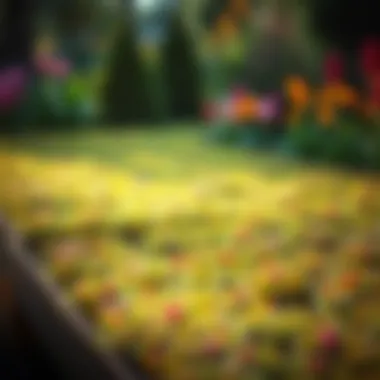Gardening Ground Cover: A Comprehensive Guide


Intro
In the realm of gardening, ground covers often rise above mere function; they sow the seeds of beauty and harmony across diverse landscapes. Often overlooked, these plant species offer much more than just a green carpet beneath our feet. They play crucial roles in preventing soil erosion, retaining moisture, and nurturing a thriving ecosystem that welcomes various wildlife. Choosing the right ground cover isn't just an aesthetic decision, but a profound step towards promoting biodiversity and sustainability.
As we journey through this guide, we'll lay out the essentials of ground covers, from their types to their ecological impacts. Whether you’re a homeowner looking to enhance your garden or a professional landscaper seeking innovative solutions, this article aims to provide you with a wealth of information that is both practical and inspiring. Let’s delve into the intriguing world of gardening ground covers to uncover how to seamlessly blend nature with artistry in your outdoor space.
Preamble to Ground Cover Plants
Ground cover plants play a vital role in gardening and landscape management, serving myriad purposes that extend far beyond mere aesthetics. These low-growing plants provide significant benefits, such as erosion control, weed suppression, and the enhancement of biodiversity in your garden. They act like nature’s carpet, wrapping around the plants and soil, taking care of what lies beneath while making the surface more inviting. Moreover, they are a fantastic solution for areas where traditional lawn grass could struggle to grow or be impractical.
Definition and Importance
The term "ground cover" refers to a variety of plants that spread over the ground's surface, effectively covering the soil. These can be herbaceous or woody, and often include resilient perennials that adapt well to varying conditions. Their importance lies not only in their visual appeal but also in the crucial ecological functions they provide.
Some notable benefits of ground cover plants include:
- Erosion Control: They hold the soil in place, minimizing the effects of runoff and wind. If you've ever watched the rain wash away dirt from a slope, you’ll appreciate the role these plants play.
- Weed Suppression: By occupying ground space, they reduce the light available to weed species, curtailing their growth.
- Soil Improvement: Certain ground covers, like clover, can fix nitrogen in the soil, improving its fertility in the long run.
- Aesthetic Appeal: Ground covers can transform even the dullest space into a lush oasis, adding color and texture year-round.
In summary, gardeners and homeowners alike must consider integrating ground cover plants, not just for their utility, but for the multitude of benefits they bring to a garden ecosystem.
Historical Context of Ground Covers in Gardening
The practice of using ground covers dates back centuries, with roots in ancient gardening traditions. Japanese gardens, for instance, often incorporate moss as a ground cover, highlighting the country’s appreciation of nature’s tranquility and beauty. In medieval Europe, ground covers adorned castle gardens, helping to define spaces while providing necessary functions such as erosion control along sloped terrains.
In North America, the use of native ground covers gained attention as gardeners sought environmentally friendly practices. As knowledge about biodiversity and ecosystem balance grew, gardeners began to recognize that these plants serve not only beautification purposes but also critical roles in fostering local ecosystems.
Over the years, the understanding of ground covers has evolved; no longer are they consigned to an afterthought in garden planning. Instead, they've emerged as integral players in landscape architecture, appreciated for their myriad benefits and adaptability. This historical context encourages today’s gardeners to employ ground covers with intention and foresight, making choices that resonate with both the current environmental conversation and their personal design goals.
Types of Ground Cover Plants
Understanding the various types of ground cover plants is essential for any gardening enthusiast. These plants not only provide aesthetic value but also play significant roles in soil health, landscape protection, and ecological balance. Choosing the right type of ground cover can make a world of difference in how a garden thrives.
Herbaceous Ground Covers
Herbaceous ground covers are delightful green carpets of foliage, often blooming with vibrant flowers. They are range from low-growing perennials like creeping thyme to bold species such as ajuga. Their importance lies in their versatility. These plants thrive in various conditions, adapting to both sun and shade. Some key benefits include:
- Soil Coverage: They effectively blank out bare soil, reducing soil erosion.
- Aesthetic Appeal: Many blooming varieties bring color and texture to a landscape.
- Low Maintenance: Once established, they generally require less upkeep compared to traditional lawns.
In addition to these practical advantages, herbaceous ground covers can also attract beneficial insects, creating a lively ecosystem in your garden.
Woody Ground Covers
Woody ground covers like creeping juniper or trailing rosemary add depth and structure to gardens, creating a rich pathway for the view. While their growth may be slower compared to herbaceous types, their resilience is noteworthy. Here are some aspects to consider:
- Drought Resistance: Many of these plants are hardy and require less water once established.
- Soil Stabilization: Their extensive root systems help in binding the soil, preventing erosion in sloped areas.
- Year-round Interest: With their evergreen foliage, woody ground covers can provide visual interest even in winter, keeping your garden lively season-round.
These ground covers can set the tone for your garden's design, providing structure and a backdrop for more vibrant, seasonal plants.
Native Ground Covers and Their Benefits
Native ground covers are a cornerstone of sustainable gardening practices. Using native species not only ensures they are well-suited to local conditions but also promotes biodiversity. Some benefits of incorporating native ground covers include:
- Environmental Harmony: They require less water and fewer chemical fertilizers because they are adapted to local soils and climates.
- Wildlife Support: These plants attract local pollinators, supporting ecosystems and enriching your garden's biodiversity.
- Cultural Significance: Many native plants have historical importance to local communities, adding cultural value to your landscape.
Implementing native ground covers can convert your garden into a mini-ecosystem, fostering a symbiotic relationship with regional flora and fauna.
Invasive Species: Risks and Management
While exploring the world of ground covers, it’s crucial to be aware of invasive species that can wreak havoc on local ecosystems. Invasive ground covers like English ivy or Japanese honeysuckle can spread rapidly, outcompeting native plants. Here’s how you can manage these threats:
- Awareness: Before planting, research the growth patterns and ecological impact of potential species.
- Regular Monitoring: Regularly check your garden for invaders. Early detection can prevent widespread issues.
- Mechanical Control: If invasives are found, manual removal or effective mulching can help keep them at bay.
- Plant Alternatives: Whenever possible, choose non-invasive native ground covers that can perform similar roles without the risks.


As responsible gardeners, understanding the balance between beauty and biodiversity ensures our landscapes remain rich and vibrant, without succumbing to threats from invasive species.
Ecological Benefits of Ground Covers
Ground cover plants offer an array of ecological benefits that can significantly enhance the health and sustainability of gardens. Understanding these advantages highlights their importance not just for aesthetic appeal but for practical gardening strategies. From preventing soil erosion to supporting biodiversity, the role of ground covers is multifaceted and essential in any landscape design.
Soil Erosion Prevention
One of the foremost benefits of ground covers is their ability to prevent soil erosion. This is particularly critical in areas prone to heavy rainfall or on slopes where soil integrity can be compromised. Ground covers establish a root network that stabilizes the soil, reducing the likelihood of runoff and sediment loss. When plants like creeping thyme or ajuga spread across the ground, their dense foliage and interwoven roots act like a natural barrier against wind and water erosion.
"A well-chosen ground cover can be a gardener's first line of defense against erosion, safeguarding the soil's top layer while promoting lush growth below."
In addition to preventing erosion, these plants also enhance soil structure. They improve water retention by allowing rain and moisture to seep into the ground, which nourishes the underlying soil. Furthermore, some ground covers can add organic matter to the soil over time as their leaves decompose, contributing to a healthier and more resilient ecosystem.
Weed Suppression Mechanisms
Ground covers also play a vital role in weed suppression, helping gardeners maintain tidy and healthy beds without resorting to chemical herbicides. As they grow, they form a thick mat that blocks sunlight from reaching potential weeds, creating an inhospitable environment for unwanted plants. For instance, Vinca minor and Creeping Juniper are known for their rapid growth and ability to outcompete weeds for resources.
The combined effect of their dense foliage and ground-hugging growth habit offers a natural form of weed control that requires minimal intervention. This not only saves time but also reduces reliance on chemical treatments, making gardening more environmentally friendly.
Microclimate Creation and Biodiversity Promotion
Ground covers contribute to creating microclimates within gardens, which can be beneficial for both plants and animals. By covering the ground, they moderate soil temperatures and improve humidity levels, which can help support a wider variety of plants. Moreover, this habitat encourages beneficial insects and pollinators, such as bees and butterflies, to flourish. Having a biodiverse ecosystem enhances the overall health of your garden.
Native ground covers, in particular, offer the best chances to promote local biodiversity. They attract native wildlife and create a balanced environment where various species can thrive. For example, plants like clover not only provide a food source for pollinators but also enhance nitrogen in the soil, benefiting neighboring plants.
Incorporating these ecological aspects into garden planning not only contributes to an appealing landscape but also supports a thriving ecosystem, benefiting homeowners and the environment alike.
Selecting the Right Ground Cover for Your Garden
Choosing the right ground cover for your garden is like finding the perfect piece of the puzzle that ties your entire landscape together. It's not just about aesthetics; selecting the ideal ground cover can enhance your garden's health and functionality. With a plethora of options available, understanding the specific needs of your space can significantly improve your gardening experience. This section will discuss essential elements such as climate, sunlight, shade tolerance, and soil type, providing you with a well-rounded framework for making informed decisions.
Climate Considerations
When it comes to ground covers, climate is a non-negotiable factor. Each species blooms best in certain temperature ranges and humidity levels. For example, creeping thyme thrives in dry, warm climates, while ferns appreciate the cooler, damp environments of shaded areas. Before you plant, take a moment to observe the weather patterns in your region. This will help you select ground covers that won’t just limp along but will instead flourish, creating a robust carpet of greenery.
"Understanding your climate is like reading the tea leaves of your garden's future. It guides your selection process and sets the stage for success."
Common ground cover plants like ajuga can handle a variety of climates, but varied conditions call for tailor-made choices. If you live in a region prone to heavy frost, consider ground covers such as snow-in-summer, which can withstand colder temperatures while providing visual appeal.
Sunlight and Shade Tolerance
Ground covers come in two main categories when it comes to light requirements—sun-loving and shade-tolerant. An area that receives full sunlight for most of the day is a different ball game compared to a shady nook that only sees filtered light. Planting the wrong ground cover can result in inadequate growth or even total failure
For sunny spots, options like sedum or creeping phlox will give your garden a vibrant look. On the flip side, if you have a shady area, consider planting periwinkle or hostas, which are designed to thrive in lower light conditions.
Assessing the sun and shade in your garden is crucial. For that shady corner that you never quite know what to do with, planting a shade-tolerant ground cover could turn it into a lush, green retreat rather than a neglected patch.
Soil Type and Nutritional Needs
Just as individuals have specific dietary needs, ground covers require certain soil types to flourish. The texture, pH level, and richness of the soil can dramatically affect growth. Sandy soils drain well but often lack nutrients, making them less suitable for nutrient-hungry species. Conversely, clay soils, while nutrient-rich, can become compacted and waterlogged, creating challenging conditions for many plants.
To determine your soil's characteristics, a simple soil test can do wonders. Understanding whether your soil is acidic, neutral, or alkaline can guide you in selecting the right ground covers that will thrive. Some plants, like creeping Juniper, need well-draining soil, while moss prefers a moisture-retentive environment. Selecting ground covers that align with your soil's properties not only promotes healthy growth but also reduces maintenance further down the road.
In summary, selecting the right ground cover requires careful consideration of climate, sunlight, and soil type. By paying attention to these factors, you set yourself up for a flourishing garden that is both functional and visually appealing.
Practical Applications of Ground Covers
Ground cover plants do far more than simply fill in bare patches of soil; they play an indispensable role in the landscape. Their applications are diverse and address various needs in both public and private gardening spaces. In this section, we elucidate why ground covers are fundamental elements of landscape design, delve into their utility in home gardens, and explore their importance in commercial settings. Each application brings unique benefits that create a more sustainable and aesthetically pleasing environment.
Ground Covers in Landscape Design
In the realm of landscape design, ground covers are the unsung heroes. They create visual interest, leading the eye across different areas of a garden and instilling a sense of harmony. Unlike traditional lawns, these plants offer less maintenance and more resilience, particularly when it comes to soil erosion and weed control.


The following are essential benefits of using ground covers in landscape design:
- Soil Stabilization: They bind the soil together with their roots, preventing erosion on slopes and surfaces that may otherwise wash away.
- Aesthetic Appeal: Choosing a variety of foliage textures and colors can turn a standard landscape into a lively mosaic of plants.
- Microclimate Creation: Certain ground covers moderate soil temperature and moisture levels, which can benefit surrounding plants.
"Ground covers add dimension and practicality to any garden setting, effortlessly merging beauty with function."
Use in Home Gardens
For homeowners, ground covers serve practical purposes beyond mere decoration. They can be your garden's best friend. Whether you're aiming to suppress weeds, deter pests, or simply make the gardening process much easier, they are an asset. Their adaptability allows them to thrive in challenging environments, such as shady areas or poor soil conditions.
Consider these practical roles:
- Low Maintenance: Once established, many ground covers need little care, allowing homeowners more time to enjoy their space.
- Weed Suppression: Their spreading nature effectively outcompetes typical garden weeds, reducing the need for constant weeding sessions.
- Action Against Compaction: They can cushion foot traffic, lessening the compaction on garden soils, which is an often overlooked issue for healthily growing plants.
Commercial and Professional Use Cases
Beyond the private garden gates, ground covers have valuable applications in commercial and professional landscapes. Businesses and public parks utilize these plants to enhance both practicality and aesthetics. For instance, they provide durable greenery in parks and commercial properties where foot traffic might otherwise lead to stripped soil and unsightly patches.
Key points to note in commercial usage:
- Cost-Effectiveness: Initially, the installation may require investment, but these plants save money over time due to their low maintenance needs and longevity.
- Sustainability: Using native ground covers in commercial spaces helps reduce the carbon footprint and supports local ecosystems.
- Brand Image: A well-maintained, lush landscape speaks volumes about a business's commitment to quality and environmental responsibility.
By understanding and embracing the numerous applications of ground covers, gardeners and landscape architects can make well-informed decisions that not only beautify the environment but also contribute positively to soil health, moisture conservation, and biodiversity.
Maintenance of Ground Cover Plants
Maintaining ground cover plants is an integral part of successful gardening, as it impacts the overall health and vibrancy of your outdoor spaces. Ground covers serve numerous purposes: they protect soil from erosion, suppress weeds, and enhance the aesthetic appeal of gardens. However, like any living organism, they require care and attention to flourish. Proper maintenance ensures that these plants continue to provide their myriad benefits, allowing your garden to thrive in both function and form.
Watering and Irrigation Techniques
Watering ground cover plants is not just about dousing them with a hose; it involves understanding their specific needs based on variety, soil type, and local climate conditions. Generally, ground covers need moderate watering, but overdoing it can lead to diseases such as root rot. Here are some practical tips:
- Irrigation Method: Consider using drip irrigation. This method conserves water and delivers moisture directly to the plant roots, encouraging deeper growth.
- Timing: Water early in the morning or late in the afternoon when temperatures are cooler, as this minimizes evaporation.
- Monitoring Soil Moisture: Stick your finger into the soil; if it’s dry an inch deep, it’s time to water. A moisture meter can also be useful for precise readings.
In brief, knowing your ground covers’ water needs contributes directly to their vitality and growth.
Fertilization and Nutrient Supply
Just like humans need vitamins and minerals, ground cover plants thrive on nutrients. However, the fertilization strategy varies with the type of plant, soil quality, and environmental factors. Here's how to manage nutrient supply effectively:
- Soil Testing: Conduct a soil test to determine pH and nutrient levels. This provides a baseline for determining what fertilizers to use.
- Organic vs. Synthetic: Organic fertilizers, such as compost or well-rotted manure, are gentler and improve soil structure. Synthetic fertilizers can act faster but may contribute to soil degradation if used excessively.
- Application Timing: Fertilizing in early spring and early fall usually yields the best results as the plants are actively growing. Spread nutrients based on the manufacturer instructions, avoiding over-application.
By giving your ground covers the right nutrients, you'll maintain lush and healthy foliage, which is crucial for the ecosystem of your garden.
Pruning and Care Practices
Pruning may not be the first thing that comes to mind when you think of ground cover plants, but it is essential for maintaining their shape and promoting healthy growth. Let’s dig into some practices:
- Routine Checks: Regularly inspect your ground covers for signs of overgrowth. Untamed growth can overshadow other plants or create an unkempt appearance.
- Timing for Pruning: Early spring is often the best time for pruning. Remove dead or damaged leaves to foster new growth and air circulation.
- Tools to Use: Invest in quality gardening shears. Sharp, clean tools create clean cuts that promote quicker healing.
Through consistent pruning, you can control how ground covers spread and maintain the balance in your garden.
Pro Tip: Maintaining a healthy balance with ground cover plants means giving them care and attention to detail. Each type of cover may have unique specifications—pay attention to those little nuances that help them thrive!
By mastering watering, fertilization, and pruning techniques, you'll not only enhance the aesthetic quality of your landscape but also ensure the ecological benefits of your ground cover plants bloom full-fledged. For more on soil health, check the resources at Wikipedia on Soil Health or consult natural gardening principles for deeper insights.
Challenges with Ground Cover Implementation
Gardening is as much about creating beauty as it is about maintaining balance. Ground cover plants offer a path towards lush, verdant spaces, but their implementation isn’t without its hurdles. Understanding the challenges that can arise allows gardeners—whether seasoned or novices—to navigate potential pitfalls and reap the countless benefits that ground covers provide.
Overgrowth and Maintenance Difficulties


One of the most frequently faced issues with ground covers is their propensity for overgrowth. While many ground cover plants are selected for their ability to spread and fill space, some species, when left unchecked, can creep into areas where they’re not welcome. This can lead to an overwhelming garden that requires more upkeep than anticipated. What starts as a neat carpet can quickly evolve into a tangled mess.
- Identify Growth Patterns: Understanding the growth habits of various species can help gardeners select appropriate varieties for their specific areas. For instance, Creeping Thyme may stay more contained compared to Vinca minor, which can spread like wildfire.
- Regular Maintenance: Frequent maintenance checks will help in managing growth. A strategic pruning schedule can keep ground covers in check, promoting healthier growth by encouraging thicker, more robust foliage without allowing them to encroach on other garden areas.
- Soil Health: Fertility of the soil plays a role too. Rich, nutrient-laden soil can promote rampant growth. A well-balanced soil is crucial, as it can aid in controlling how aggressively certain ground covers spread, finding a happy medium for your garden.
Compatibility with Other Plants
Ground covers can become double-edged swords when it comes to their relationship with other plants. While they can coexist beautifully, helping to create vibrant ecosystems, incompatibility can lead to problems.
- Light and Nutrient Competition: Some ground covers might block sunlight or compete for nutrients with neighboring plants. For instance, a vigorous ground cover may outcompete weaker plants in terms of necessary resources, stunting their growth.
- Choose Wisely: When selecting ground covers, it’s essential to consider the specific needs of all plant species in your garden. Identify which plants thrive in similar conditions. For example, combining Daylilies with Ground Morning Glory might offer both visual and compatibility benefits, as they often enjoy similar soil and light conditions.
- Zoning: Using zones is a clever tactic. Consider placing sunlight-loving plants alongside ground covers that tolerate partial shade to balance the competition for resources.
Pest and Disease Management
Like any other flora, ground covers can fall prey to pests and diseases, which can wreak havoc on an otherwise harmonious garden. The dense growth that often characterizes these plants can lead to hiding places for unwanted pests, complicating management strategies.
- Regular Inspection: Regular checks can be beneficial; looking at the underside of leaves or around the base of plants can help catch infestations early.
- Diversity is Key: Encouraging a diverse ecosystem by planting different types of ground covers can deter pests. For instance, combining clover with other low-growing plants can help reduce aphid populations, as they thrive less in diverse environments.
- Natural Solutions: Chemical treatments can sometimes do more harm than good, affecting beneficial insects. Embracing natural pest management methods—like beneficial nematodes or companion planting with marigolds—can foster a healthier balance.
In summary, while gardening with ground covers comes with distinct challenges, being aware of these potential issues allows gardeners to implement solutions effectively. There’s no recipe for perfection in gardening, but with careful selection, thoughtful planning, and proactive maintenance, the benefits of these plants can far outweigh the difficulties.
Ground Covers and Sustainability
Ground cover plants hold a crucial role in the broader context of sustainable gardening practices. As climate change and environmental concerns loom, the necessity for sustainable gardening methods becomes even more pronounced. Here, ground covers emerge not just as aesthetic additions to gardens, but as powerful tools for enhancing environmental responsibility.
Utilizing ground covers contributes significantly to the health of ecosystems, offering various benefits that align closely with sustainable gardening principles. These plants can improve the natural balance of gardens while reducing resource consumption.
Reduction of Carbon Footprint
Ground cover plants can assist in reducing the carbon footprint. Through photosynthesis, they absorb carbon dioxide from the atmosphere, contributing to cleaner air. More importantly, by cultivating a diverse range of ground covers, carbon emissions can be minimized. For example, native plants like creeping thyme or blue fescue generally require less water and fewer chemical inputs. This means they sustain lower environmental costs over their lifecycle. In regions where lawns dominate, replacement with low-maintenance ground covers transforms landscapes while cutting down on gas emissions associated with lawn care equipment.
Enhancing Soil Health and Fertility
The health of soil is paramount to any gardening endeavor, and ground covers play a vital part in this. Specifically, they enhance soil structure and fertility through their root systems. Ground covers like clover or vetch can fix nitrogen in the soil, enriching it naturally. This reduces the need for chemical fertilizers, which can harm both plants and local groundwater. Moreover, as these plants grow and decompose, they contribute organic matter back into the soil. This process not only improves soil texture but also fosters microbial diversity, leading to a healthier ecosystem.
"Incorporating ground cover plants is not merely a cosmetic choice; it’s a step towards fostering a resilient and regenerative gardening practice."
Conserving Water Resources
One of the key challenges in modern gardening is water conservation. Ground cover plants are adept at reducing water requirements by providing shade to soil and thus minimizing evaporation. Plants such as sedums or ground morning glory can effectively retain moisture in the soil, which is particularly important in arid climates. These covers act like living mulch, suppressing weeds that compete for moisture and nutrients. Planting drought-resistant ground covers also aligns with sustainable practices, ensuring gardens remain lush with minimal water input.
In summary, the intersection of ground covers and sustainability is not just beneficial; it is essential for future gardening practices. These plants contribute to climate resilience, improve soil health, and are instrumental in water conservation strategies. As we move forward, a commitment to utilizing ground covers can help transform ordinary gardens into thriving ecosystems that support both human and environmental health.
Future Trends in Ground Cover Gardening
The world of gardening is in constant flux, shaped by innovations, evolving technology, and shifting perceptions of the environment. Ground cover gardening is no exception, as homeowners and landscape designers alike seek to enhance their gardens through sustainable practices and new varieties. Recognizing and adapting to these trends can lead to richer, more diverse gardening experiences. It's not merely about aesthetics; it's also about employing methods that are environmentally conscious and forward-thinking.
Innovative Ground Cover Varieties
The advent of new plant cultivars is a game-changer in ground cover gardening. Varieties that were once limited to traditional choices are now infused with traits meeting modern gardening needs. For instance, some new hybrid creeping thyme species not only boast beautiful blooms but also require far less water than their predecessors.
- Drought-Resistant Species: In regions facing water scarcity, drought-tolerant ground covers like sedum or Delosperma offer resilience, allowing homeowners to maintain lush-looking plots without heavy irrigation.
- Color and Texture: Varieties like Ajuga reptans, commonly known as carpet bugle, come in a range of colors from deep greens to striking purples. This diversity adds layers of visual interest and aesthetic charm to gardens.
- Pollinator-Friendly Options: As awareness about sustaining bee populations rises, ground covers like clover or low-growing native flowers provide crucial habitats and food sources.
It’s fascinating how inventive breeding and cross-pollination pursuits are sculpting these innovative ground cover options. These shifts point toward embracing biodiversity—a refreshing approach that adds vibrant life and environmental benefits to our gardens.
Integration with Smart Gardening Solutions
Smart technology isn't just for indoor spaces anymore; it's making waves in garden management too. The integration of smart solutions into ground cover gardening allows for tailored care of plants, significantly reducing labor and resource expenditure while maximizing growth potential.
- Smart Irrigation Systems: These utilize soil moisture sensors and climate data to optimize watering schedules. This helps in achieving the perfect hydration for your ground covers, ensuring they thrive without over or under-watering.
- Mobile Apps for Garden Management: Apps can track plant health, offer pest management tips, and even suggest ideal ground covers based on your local soil and climate conditions. For busy gardeners, these tools can help maintain a vibrant and healthy garden on autopilot.
- Fitness Trackers for Plants: Emerging technologies such as biophysical sensors are now used to monitor soil health in real-time, providing insights into nutrient levels and potential pest attacks before they cause significant damage.
Embracing these smart gardening innovations signifies a shift towards more sustainable, efficient practices that align with modern living while respecting traditional gardening values.
Community Initiatives and Education
For ground cover gardening to thrive, community involvement and educational programs play a vital role. Through shared knowledge and resources, gardening enthusiasts can foster a more sustainable approach to landscapes in their neighborhoods. Various local initiatives are also popping up that encourage this communal exchange.
- Workshops and Classes: Local gardening clubs and community centers are increasingly offering classes on sustainable gardening practices, focusing on ground covers. Topics range from selecting the right plants to understanding eco-friendly maintenance approaches.
- Community Gardens: These gardens serve as hands-on learning environments, enabling participants to experiment with different ground covers and see firsthand what works best in their region. It cultivates a sense of belonging and shared responsibility toward environmental stewardship.
- Online Forums and Social Media Groups: Platforms like Reddit and Facebook have become hubs for gardening enthusiasts. These digital spaces allow for instant sharing of successful ground cover strategies, failures, and innovative solutions, enhancing collective knowledge and passion.
By promoting education and community involvement, we collectively elevate our gardening practices, making them more sustainable and enriching for everyone. After all, gardening can be as much about the people as it is about the plants.
Getting ahead in ground cover gardening doesn't just rely on what you know, but also on who you share that knowledge with.



